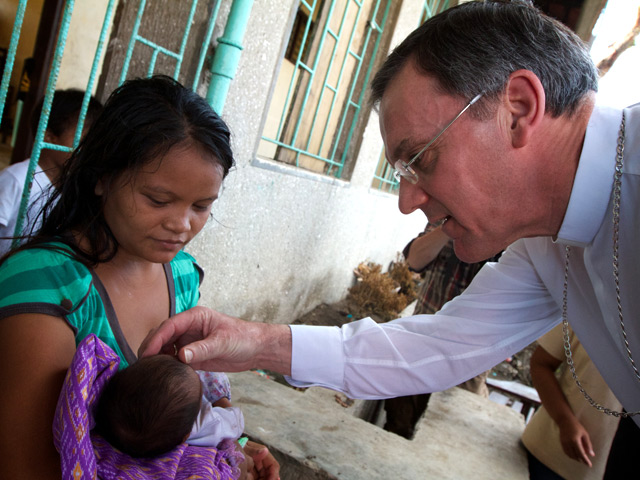
Solidarity Visit to the Philippines, 1-6 December 2013
Today marks the final day of Bishop John Arnold’s six-day visit to the Philippines where he witnessed first-hand the devastation caused by Typhoon Haiyan.
Bishop John was asked to travel to the region on behalf of Archbishop Vincent Nichols, to show solidarity in a time of distress and to be a presence for the 120,000 Filipinos in the UK.
The Chair of the Catholic Church’s agency for overseas aid and development, CAFOD, visited some of the worst-hit areas including Tacloban – the city at the heart of the area that sustained the most damage:
“It is the few miles of quite densely populated coast from Tacloban to Palo, Tanauan and Cogon that took the worst damage and loss of life. Tanauan had 1,000 casualties, Palo another 2,000 – these few miles had about 5,000 of the 6,000 confirmed dead. Of course the death toll is not finalised, particularly as many rural areas are still not full accounted for. Pylons were down in their hundreds, with big trees uprooted and the same level of destruction on the buildings.
“We were told that, to a large extent, the food needs are now being met but the sight of children begging was difficult.”
On the final full day, Thursday 5 December, Bishop John traveled north from Cebu City, the second largest city in the Philippines, to Cebu Island’s northernmost tip:
“It all became very evident very suddenly. We seemed to come around a corner of the coast road to see real damage.
“The typhoon was very clearly defined in its path. Within just a couple of miles we knew all too well that this is a disaster zone. All along the road were fallen trees, many had fallen across the road and their trunks cut to free the road. In some meadows every tree had been flattened and they lay in parallel on the ground.
“The houses had been destroyed. Again the estimate is that 90% of homes are damaged and 50% of those are completely destroyed. After three weeks many families have constructed shacks using the debris and there were a lot of emergency tents provided by the government and others.
“Even the most robust of buildings have damage – it is particularly the roofs that have been peeled back and many seemed to have flown a long way from their buildings. This had been a real danger to people as so many of the roofs of houses were made of corrugated sheeting which, when tossed about by the fierce wind, are like enormous razor blades doing damage to property and people.”
Bishop John Arnold traveled the region with Matthew Carter, Humanitarian Director at CAFOD and the MP Jim Murphy, the Shadow Secretary of State for International Development.
cafod.org.uk/Give/Donate-to-Emergencies/Typhoon-Haiyan-appeal
If you are able, please consider supporting CAFOD’s Typhoon Haiyan relief appeal.
rcdow.org.uk/diocese/bishop-john-arnold
Read Bishop John Arnold’s blog diary from the areas worst-hit by Typhoon Haiyan by visiting his profile page on the Diocese of Westminster’s website. Use the blog menu on the left-hand-side.
blog.cafod.org.uk/tag/john-arnold/
CAFOD’s blog also carries posts from its Chair on the visit to the Philippines.
flickr.com/photos/catholicwestminster
The image that accompanies this article comes from the Diocese of Westminster’s Flickr stream. View more photos on the link above.